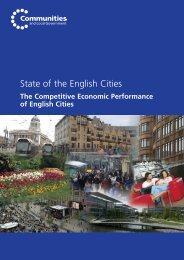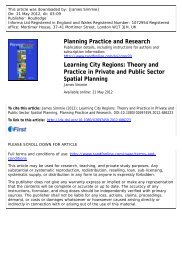History Matters: Path dependence and innovation in British city ...
History Matters: Path dependence and innovation in British city ...
History Matters: Path dependence and innovation in British city ...
You also want an ePaper? Increase the reach of your titles
YUMPU automatically turns print PDFs into web optimized ePapers that Google loves.
average <strong>in</strong> all forms of <strong><strong>in</strong>novation</strong> outcome<br />
except ‘advance management techniques’,<br />
whereas Swansea underperforms <strong>in</strong> all forms<br />
of <strong><strong>in</strong>novation</strong> outcomes, suggest<strong>in</strong>g that<br />
the cumulative characteristics of the local<br />
<strong><strong>in</strong>novation</strong> system contribute to the path<br />
dependent nature of development. Once<br />
a critical mass of <strong><strong>in</strong>novation</strong> is reached it<br />
appears to become self-re<strong>in</strong>forc<strong>in</strong>g, as dist<strong>in</strong>ct<br />
identifiable <strong><strong>in</strong>novation</strong> <strong>and</strong> technological paths<br />
emerge, as <strong>in</strong> Cambridge. Not only is there a<br />
lack of critical mass <strong>in</strong> Swansea, which h<strong>in</strong>ders<br />
such a self-re<strong>in</strong>forc<strong>in</strong>g process, the nature of<br />
the exist<strong>in</strong>g <strong><strong>in</strong>novation</strong> is also generally less<br />
radical. Respondents confirm that there is<br />
limited R&D with<strong>in</strong> Swansea, which <strong>in</strong>hibits<br />
knowledge creation <strong>and</strong> <strong><strong>in</strong>novation</strong> outcomes.<br />
One of the few Swansea companies cited<br />
as successful <strong>in</strong> <strong><strong>in</strong>novation</strong> is Corus, which<br />
sponsors research <strong>in</strong> the University Eng<strong>in</strong>eer<strong>in</strong>g<br />
School. But while others mention the potential<br />
for <strong><strong>in</strong>novation</strong> <strong>in</strong> the ICT sector <strong>in</strong> the <strong>city</strong>, the<br />
feel<strong>in</strong>g is that most <strong><strong>in</strong>novation</strong> is not lead<strong>in</strong>g<br />
edge:<br />
“Whether you say it’s product <strong><strong>in</strong>novation</strong> or<br />
whether it’s just that they’re us<strong>in</strong>g software,<br />
<strong>and</strong> develop<strong>in</strong>g web pages, <strong>and</strong> these<br />
types of th<strong>in</strong>gs...it’s mid-level <strong><strong>in</strong>novation</strong>.”<br />
[Interview SW003]<br />
Another respondent from the Council<br />
comments on the difficulty mov<strong>in</strong>g from the<br />
ideas stage to patent<strong>in</strong>g:<br />
“With the patents idea, to make it<br />
commercially viable, is a hell of a leap of<br />
faith. In fact, we <strong>and</strong> the university have<br />
discussed that on numerous occasions,<br />
because we’ve done jo<strong>in</strong>t <strong>in</strong>itiatives where<br />
we’ve encouraged people to come forward<br />
with their ideas, but where we always<br />
failed, is gett<strong>in</strong>g that commercialisation of<br />
those ideas. Mak<strong>in</strong>g them venture capital<br />
ready, <strong>and</strong> that’s the huge th<strong>in</strong>g.” [Interview<br />
SW005]<br />
Hav<strong>in</strong>g ready access to venture capital – <strong>and</strong><br />
be<strong>in</strong>g viewed as a highly <strong>in</strong>novative place by<br />
venture capital organisations – has certa<strong>in</strong>ly<br />
been a major factor beh<strong>in</strong>d Cambridge’s<br />
success. As the Cambridge high-tech cluster<br />
has developed, a local venture capital <strong>in</strong>dustry<br />
has emerged to serve it – a form of coevolution<br />
– with some significant players,<br />
<strong>in</strong>clud<strong>in</strong>g Amadeus <strong>and</strong> Cambridge Gateway<br />
Fund. Accord<strong>in</strong>g to Library House some<br />
108 companies <strong>in</strong> the Cambridge cluster<br />
are venture-backed, totall<strong>in</strong>g £600m of<br />
<strong>in</strong>stitutional capital, mak<strong>in</strong>g it second only to<br />
London, <strong>and</strong> fourth <strong>in</strong> Europe (Library House,<br />
2007). Thirty-six per cent of venture-backed<br />
cluster companies are <strong>in</strong> the ‘healthcare <strong>and</strong> life<br />
sciences’ sector. There is also a thriv<strong>in</strong>g local<br />
bus<strong>in</strong>ess angel community. The general view is<br />
that access to venture capital is a strength of<br />
the cluster:<br />
“Not only is there now a healthy<br />
locally-based VC market, Cambridge’s<br />
position close to London means that VC<br />
organisations there are with<strong>in</strong> easy reach,<br />
<strong>and</strong> view Cambridge favourably. I don’t<br />
th<strong>in</strong>k venture capital is a problem, though<br />
some argue that the <strong>British</strong> venture capital<br />
<strong>in</strong>dustry could steer more money <strong>in</strong>to<br />
high-tech activity. The key issue is hav<strong>in</strong>g<br />
entrepreneurs who can conv<strong>in</strong>ce <strong>in</strong>vestors,<br />
to have ideas that can be brought to<br />
market. Cambridge does well here, but can<br />
do better.” [Interview CAMB004]<br />
Knowledge acquisition <strong>and</strong> adoption<br />
External knowledge networks are key to<br />
external knowledge identification <strong>and</strong><br />
absorption. We have seen that an estimated<br />
96.5 per cent of OECD new research knowledge<br />
is created outside the UK (AIM, 2008). This<br />
makes <strong>in</strong>ternational knowledge networks<br />
particularly significant <strong>in</strong> br<strong>in</strong>g<strong>in</strong>g <strong>in</strong> new ideas<br />
<strong>and</strong> knowledge to particular localities.<br />
CIS4 data show that Cambridge firms are<br />
generally much more <strong>in</strong>tegrated <strong>in</strong>to various<br />
networks (government partners, universities,<br />
consultants, customers <strong>and</strong> suppliers) than<br />
Swansea firms (Figure 31). Particularly strik<strong>in</strong>g<br />
is the extent to which Cambridge far outstrips<br />
Swansea on almost every type of network,<br />
<strong>in</strong>dicat<strong>in</strong>g that its firms have much more<br />
extensive <strong>and</strong> <strong>in</strong>tensive relationships with other<br />
firms <strong>and</strong> bodies – <strong>and</strong> potential access to<br />
much richer sets of external knowledge.<br />
“It may be that some Cambridge high-tech<br />
firms have relationships with other local<br />
firms, <strong>and</strong> might collaborate <strong>in</strong> some way<br />
with them. But my impression is that for<br />
most, like us, the customer base is national<br />
<strong>and</strong> even more importantly <strong>in</strong>ternational,<br />
so l<strong>in</strong>ks outside Cambridge are the key<br />
ones. Our fastest grow<strong>in</strong>g market is the<br />
Far East <strong>and</strong> Ch<strong>in</strong>a, so that is where we<br />
look for relationships with customers <strong>and</strong><br />
manufacturers. Global relationships matter<br />
much more than local ones. To survive<br />
you have to th<strong>in</strong>k globally.” [Interview<br />
CAMB002]<br />
54













